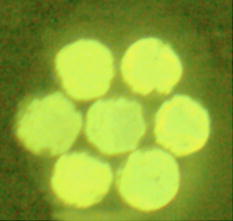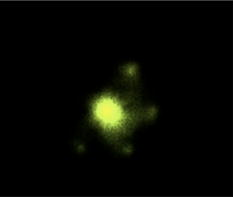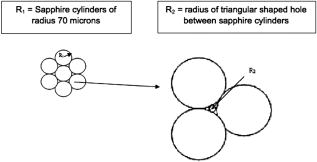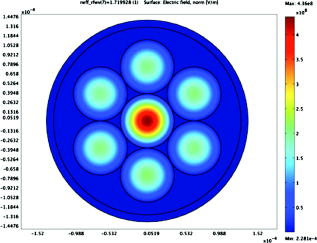|
|
1.IntroductionOptical fibers find wide use in communication and sensing systems. They can be produced from many different materials such as glass, plastic, and single crystals in a large variety of configurations and dimensions. Long distance communication fibers are composed of a solid glass core surrounded by a solid glass cladding of lower refractive index, which serves to confine light to the central core, thereby minimizing the transmission loss. New types of optical fibers have recently been developed that promise to play an important role in both sensing and communication applications. Photonic crystal fibers (PCFs), which belong to the class known as microstructured optical fibers (MOFs) or holey fibers, were first reported in the 1990s1, 2, 3 and have been the subject of intensive research ever since. Most PCFs consist of a pure silica core surrounded by ordered longitudinal air holes in the cladding region. Many PCF structures have been proposed (mainly differing in the size, spacing, and number of air holes present in the cladding region), including hollow core PCFs. Photonic crystal fibers have ordered holes in which the holes occur in a regular or periodic pattern (giving rise to the term “crystal”) that extends along the length of the fiber. This stems directly from the fact that the fibers are drawn from preforms, which contain tubes that run the entire length of the preform. Recently, a new type of holey fiber, called the random hole optical fiber (RHOF), has been developed.4 In this type of fiber, thousands of longitudinal holes, which surround the solid central optical core, are random in size, spatial location, and extent along the optical axis.5 Both the ordered hole and random hole fibers have some interesting properties for sensing applications6, 7, 8, 9, 10 as well as for potential fibers for home applications.11 Photonic crystal fibers or “ordered hole” fibers have generated a significant amount of interest due to their unique properties, including an extremely small core size, single mode guidance over a very large wavelength range, and guidance through a hollow core.4, 5, 6, 7 If the size and spacing of the holes in the fiber are controlled properly, a photonic bandgap fiber can be produced. If the size and/or spacing of the holes does not permit a photonic bandgap to exist, the fiber can still guide light by lowering the average effective index in the cladding region. Many useful fibers and devices have been developed based on these ordered hole PCFs. However, these are all based on silica fibers, which limit the maximum use temperature due to fiber crystallization, fiber reactions with the environment, or glass creep under stress. Many industrial applications require sensors to be able to withstand high temperatures and harsh environments. Single crystal sapphire has a high melting point, approximately , which provides a high laser damage threshold.12 It also has superior mechanical characteristics, excellent chemical resistance in corrosive environments,13 high hardness, and reasonably good optical propagation. The transmission window for single crystal sapphire extends beyond (with about a 20% transmission at wavelengths as long as for a -thick sample). Other important properties of single crystal sapphire include good nonlinearity in the range14 and high availability, since single crystal sapphire can easily be grown by the laser heated pedestal growth (LHPG) method.15 Extensive research has been performed to develop sapphire fiber-based sensors. Various sensors, including intrinsic and extrinsic interferometers, polarimetric devices, and birefringence-balanced lead-insensitive sensors, have been demonstrated for measurement of various physical parameters at high temperatures.16, 17, 18, 19, 20 However, full utilization of these devices has not been realized in large part due to the lack of appropriate high temperature claddings on sapphire optical fibers. The lack of cladding on single crystal sapphire fibers results in higher environmental vulnerability of the single crystal sapphire fibers due to fluctuations in the optical signal as a result of materials adsorbed onto the fiber surface or reactions at the sapphire surface; higher modal volume resulting in higher phase differences between low and high order modes; and increased sensitivity to the effects of fiber bending due to the loss of the higher order modes. In this work, we report for the first time on the design and fabrication of a sapphire PCF. 2.ProcedureSingle crystal sapphire fibers, with an outer diameter of approximately , were cleaved into seven pieces approximately each. The fibers were cleaned in a series of steps that included rinsing in alcohol, distilled water, acetone, and diluted phosphoric acid. The fibers were assembled in a pattern that consisted of a central fiber surrounded by six outer fibers, forming a symmetric ring around the central fiber. A schematic of the fiber placement is shown in Fig. 1. The fibers were held in place using platinum wire. The platinum wire was wound around the entire length of the fibers in several locations to preserve their ordered arrangement. After the process was completed, the fibers were cleaned again. The fiber bundle was then placed on a porous high purity alumina plate (Micromass, from Porvair Advanced Materials, Norfolk, United Kingdom) and then inserted into a Deltech furnace. The fibers were heated at for . The fibers were then removed from the furnace and allowed to cool to room temperature. Polishing of the fibers was performed with diamond polishing paper of various grits. To accomplish this, the fibers were mounted in a polishing fixture and bonded using a thermoplastic adhesive. 3.Results and DiscussionLet the radius of the sapphire cylinders shown be and the radius of the hole that would fit between the cylinders and just touch each cylinder be ; then the radius ratio of would be 0.155 by simple geometrical considerations.12 If the radius of the sapphire cylinders is , then the radius of the holes would be approximately . This would be the upper bound on the hole size, as sintering of the sapphire cylinders will tend to decrease the size of the hole. The polished end-face of one of the fibers produced is shown in Fig. 2. The sample was mounted in Crystal Bond thermoplastic adhesive for polishing, and some of the Crystal Bond can still be seen on the edges of the fibers. The micrograph was taken in reflected light to highlight the structural aspects of the fiber. Fig. 2Optical micrograph of fiber end-face (reflected light image) with the diameter of the sapphire elements shown as .  The fibers were grown with the c-axis of the crystal extending along the optical axis of the fiber (along the length of the fiber). Since single crystal sapphire has a hexagonal crystal structure, the two axes perpendicular to the c-axis are equivalent and are referred to as the a-axis. So the cross section of the fiber shown is taken perpendicular to the c-axis of each of the fibers. Figure 3 shows an optical micrograph of the fiber taken in transmitted light under incandescent white light illumination from the backside of the fiber, with no lens or other focusing device used. Fig. 3Optical micrograph of the photonic crystal sapphire fiber with the diameter of the sapphire elements shown as (transmission mode image).  As can be seen in this photograph, a significant amount of light is propagating in the central “core” fiber, which would be consistent with confinement in the core due to the lowering of the average effective refractive index by the holes in the PCF structure. This has been discussed extensively in the literature for silica-based PCFs, but we believe this is the first time that this has been demonstrated in a sapphire PCF structure. The bright region in the center of the micrograph is coincident with the central sapphire cylinder. Very faint light spots can be seen surrounding the central fiber. These correspond to the center positions of the sapphire cylinders surrounding the central “core” sapphire cylinder. The sapphire PCF shown was heated to successively higher temperatures, up to , demonstrating the extremely high temperature capability of these fibers. Single crystal sapphire in general is known to have excellent high temperature performance and excellent corrosion resistance, both of which were expected to be inherited by the sapphire PCFs. Modeling of the modes that are predicted to exist in these fibers has been attempted with COMSOL (Burlington, Massachusetts) Multiphysics 3.5a modeling software. The fiber was modeled to scale and solved with a mesh accuracy of 0.0780. The fundamental mode at a free space wavelength of is shown in Fig. 4. The other modes that exist in this fiber are not shown due to length limitations of this letter. The computer modeling of these new sapphire fiber structures is ongoing. The results of these efforts will be presented in a future paper. 4.ConclusionA sapphire photonic crystal fiber structure is presented. The structure consists of six holes surrounding the solid central core. Although this type of structure has been reported in silica-based fibers, this represents the first time that a photonic crystal fiber has been fabricated in single crystal sapphire. The sapphire PCFs were heated to , demonstrating the excellent temperature capability of these fibers. AcknowledgmentsThe authors would like to gratefully acknowledge funding for this work from DOE NETL under contract number FC26-05NT42441. ReferencesT. A. Birks, J. C. Knight, and P. S. J. Russell,
“Endlessly single-mode photonic crystal fiber,”
Opt. Lett., 22 961
–963
(1997). https://doi.org/10.1364/OL.22.000961 0146-9592 Google Scholar
J. C. Knight, T. A. Birks, P. J. Russell, and J. P. de Sandro,
“Properties of photonic crystal fiber and the effective index model,”
J. Opt. Soc. Am., 15 748
–752
(1998). https://doi.org/10.1364/JOSAA.15.000748 0030-3941 Google Scholar
J. C. Knight, T. A. Birks, P. St. J. Russell, and D. M. Atkin,
“All-silica single-mode optical fiber with photonic crystal cladding,”
Opt. Lett., 21 1547
–1549
(1996). https://doi.org/10.1364/OL.21.001547 0146-9592 Google Scholar
D. Kominsky, G. Pickrell, and R. Stolen,
“Generation of random-hole optical fiber,”
Opt. Lett., 28 1409
–1411
(2003). https://doi.org/10.1364/OL.28.001409 0146-9592 Google Scholar
G. Pickrell, D. Kominsky, R. Stolen, F. Ellis, J. Kim, A. Saffaai-Jazi, and A. Wang,
“Microstructural analysis of random hole optical fibers,”
IEEE Photon. Technol. Lett., 16
(2), 491
–493
(2004). https://doi.org/10.1109/LPT.2003.819403 1041-1135 Google Scholar
T. Nasilowski, R. Kotynski, F. Berghman, and H. Thienpont,
“Photonic crystal fibers—state of the art and future perspectives,”
Proc. SPIE, 5576 1
–12
(2004). https://doi.org/10.1117/12.581509 0277-786X Google Scholar
B. Temelkuran, S. D. Hart, G. Benoit, J. D. Joannopoulos, and Y. Fink,
“Wavelength-scalable hollow optical fibers with large photonics bandgaps for laser transmission,”
Nature, 420 650
–653
(2002). https://doi.org/10.1038/nature01275 0028-0836 Google Scholar
M. Korwin-Pawlowski, G. Pickrell, and P. Mikulic,
“Long period gratings on random hole optical fibers and microstructured disordered fibers,”
Proc. SPIE, 6767 67670D
(2007). https://doi.org/10.1117/12.735559 0277-786X Google Scholar
G. Pickrell, W. Peng, and A. Wang,
“Random-hole optical fiber evanescent-wave gas sensing,”
Opt. Lett., 29 1476
–1478
(2004). https://doi.org/10.1364/OL.29.001476 0146-9592 Google Scholar
B. Alfeeli, G. Pickrell, M. Garland, and A. Wang,
“Behavior of random hole optical fibers under gamma ray irradiation and its potential use in radiation sensing applications,”
Sensors, 7
(5), 676
–688
(2007). https://doi.org/10.3390/s7050676 0746-9462 Google Scholar
G. Pickrell, C. Ma, and A. Wang,
“Bending-induced optical loss in random-hole optical fibers,”
Opt. Lett., 33 1443
–1445
(2008). https://doi.org/10.1364/OL.33.001443 0146-9592 Google Scholar
W. D. Kingery, H. K. Bowen, and D. R. Uhlmann, Introduction to Ceramics, John Wiley and Sons, New York
(1976). Google Scholar
G. R. Pickrell,
“High-temperature alkali corrosion kinetics of low-expansion ceramics (alkali corrosion),”
Virginia Polytechnic Institute and State University,
(1994). Google Scholar
K. Wang, L. Qian, H. Luo, P. Yuan, and H. Zhu,
“Ultrabroad supercontinuum generation by femtosecond dual-wavelength pumping in sapphire,”
Opt. Express, 14 6366
–6371
(2006). https://doi.org/10.1364/OE.14.006366 1094-4087 Google Scholar
R. S. Feigelson,
“Pulling optical fibers,”
J. Cryst. Growth, 79
(1–3), 669
–680
(1986). https://doi.org/10.1016/0022-0248(86)90535-X 0022-0248 Google Scholar
H. Xiao, J. Deng, G. Pickrell, R. G. May, and A. Wang,
“Single-crystal sapphire fiber-based strain sensor for high-temperature applications,”
J. Lightwave Technol., 21 2276
(2003). https://doi.org/10.1109/JLT.2003.816882 0733-8724 Google Scholar
A. Wang, S. Gollapudi, R. G. May, K. A. Murphy, and R. O. Claus,
“Advances in sapphire-fiber-based interferometric sensors,”
Opt. Lett., 17
(21), 1544
–1546
(1992). https://doi.org/10.1364/OL.17.001544 0146-9592 Google Scholar
A. Wang, S. Gollapudi, K. A. Murphy, R. G. May, and R. O. Claus,
“Sapphire-fiber-based intrinsic Fabry-Perot interferometer,”
Opt. Lett., 17
(14), 1021
–1023
(1992). https://doi.org/10.1364/OL.17.001021 0146-9592 Google Scholar
A. Wang, P. Zhang, K. A. Murphy, and R. O. Claus,
“Sapphire fiber-based polarimetric sensors for high temperature applications,”
Proc. SPIE, 2191 13
–22
(1994). https://doi.org/10.1117/12.173942 0277-786X Google Scholar
A. Wang, G. Z. Wang, K. A. Murphy, and R. O. Claus,
“Birefringence-balanced polarization-modulation sapphire optical fiber sensor,”
Opt. Lett., 17 1391
(1992). https://doi.org/10.1364/OL.17.001391 0146-9592 Google Scholar
|



